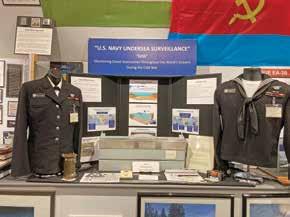
2 minute read
The Cold War Comes Alive at Vint Hill Museum
The Cold War Comes Alive at Vint Hill Museum
By Miles Kresic
Advertisement

The Cold War Museum in Vint Hill
Photos by Miles Kresic
The Cold War Museum at Vint Hill is one of Fauquier County’s best kept secrets, a treasure trove of donated artifacts and exhibits assembled by experts who lived through the Cold War era.
It’s situated on the site of the former Vint Hill Farms Station, which once functioned as a top secret signal intelligence facility working in counter intelligence for the U.S. Army during and after World War II.
Now known as the Vint Hill Village Green Community Center, it’s the perfect place to learn about one of the most tense periods in American history.
The museum was founded in 1996 by Gary Powers Jr. and his friend, John Welch. Gary’s father, Francis Gary Powers, was the American pilot who was shot down over Soviet territory in his U2 spy plane in 1960.
On a recent Saturday afternoon, Jason Hall, executive director of the museum, highlighted a few of its unique exhibits. The Cold War was a period of geopolitical tension between the Soviet Union and the U.S. and their respective allies after World War II to the 1991 dissolution of the Soviet Union..
“Our tagline here is ‘real people explaining the real things,’” Hall said.
The museum’s collection is entirely donated, and is renowned in Cold War research circles. In fact, the Spy Museum in Washington and the National Cryptologic Museum at Fort Meade in Maryland both borrow many artifacts from Vint Hill.
“We don’t borrow artifacts from the Spy Museum, they borrow artifacts from us,” Hall said. “The staff and historians of the CIA Museum, NSA’s Cryptologic Museum, the FBI, all like what we do when they see it.”
Fauquier County provided funding for the initial renovation. The museum is publicly owned, and receives little funding. Instead, it relies on bi-annual fundraisers, memberships, personal donations, private tours and paid presentations, including book discussions, sessions on counter intelligence and, of course, Cold War history.
Plans for a second location, likely in Lorton, are underway. The museum’s collection is extensive and exceeds the capacity of the current building, once a barn on the old farm property.
“There’s practically no space to put anything else,” Hall said. “That itself is not unusual for American museums which are not even showing more than three percent of their collection. Almost everything we have is next door in storage.”
The museum’s collection includes a Soviet surfaceto-air missile, one of the artifacts the museum loans out to other locations. The second Lorton location will be at ta former Nike missile site, one of several old missile defense facilities designed to protect Washington D.C. in the event of a nuclear attack.
Despite receiving little publicity, the museum has become popular by word of mouth, particularly from area residents in and around Warrenton.
“We get visitors from around the world, but the vast majority are local.” Hall said. “All the businesses here really value the history of Vint Hill, and as the main custodian of that history, we’re very happy to work with them to help visitors have a good time when they visit.”

One of many fascinating displays at the museum.
The Cold War Museum is located at 7142 Lineweaver Road in Warrenton. For more information, call 540-341-2008 or visit coldwar.org.










